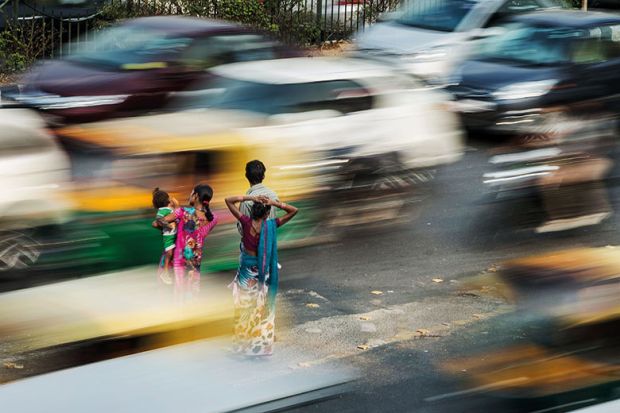The world’s largest general election is now in full swing, but higher education is well down the list of issues concerning the hundreds of millions of people voting.
India’s rates of unemployment, inflation and corruption are among the issues far outranking the state of its universities, according to polling in the country’s media, as voters decide whether to re-elect the ruling coalition led by Narendra Modi’s Bharatiya Janata Party (BJP).
But if unemployment is the main problem facing the country, higher education might well be argued to be one of the best solutions – particularly given that about half of India’s 1.3 billion people are under 25. But with more than 35 million students already enrolled in India’s patchwork of about 900 central, state and private universities, as well as 40,000 colleges and 10,000 other kinds of degree-awarding institutions, clearly questions need to be answered about whether the country’s higher education system is working as well as it could to equip that vast talent pool with the skills needed to drive the economy forward.
This makes it a little surprising that higher education is such a “non-issue” in the polls, says Pushkar, director of the International Centre Goa. “Unemployment is a bigger issue than ever before, and, in recent years, there has been a lot of news on educated unemployed or under-employed [people].”

However, the lack of attention paid to universities in the campaign is also predictable, he argues, as “higher education has never really made news during elections” and, by and large, the major parties such as the BJP and the opposition Indian National Congress still set the agenda.
There may also be good reasons why politicians in India do not want to draw too much attention to standards in the country’s universities. Compared with that other rapidly developing Asian giant, China, universities in India are still struggling to make their mark on the world stage. While China now has seven institutions in the top 200 of the Times Higher Education World University Rankings, India still has none, with only one – the Indian Institute of Science – in the top 300. Meanwhile, Indian students with the money to do so still appear to be voting with their feet on the quality of their own university system by heading abroad in increasing numbers, just as the growth in outbound student mobility from China appears to be slowing as its domestic system gets stronger.
A big part of the reason is that outside the few highly ranked institutions, India’s higher education system faces a multitude of issues. Chief among them is its complexity, which can make it difficult to see where policymakers should even start in making improvements. Is it best to focus on the few universities that have a chance to become world class, rather than undertaking the gargantuan task of addressing the system as a whole? Does the answer for India even lie in public education, or does the private sector – in which two-thirds of Indian students are educated – offer more promising possibilities? What level of funding and autonomy might be sufficient to raise Indian higher education up to world standards, and can the country afford it?
These questions may not be electoral issues, but the answers that politicians come up with (or don’t) will have a huge impact on India’s future.
(Ranking performance)
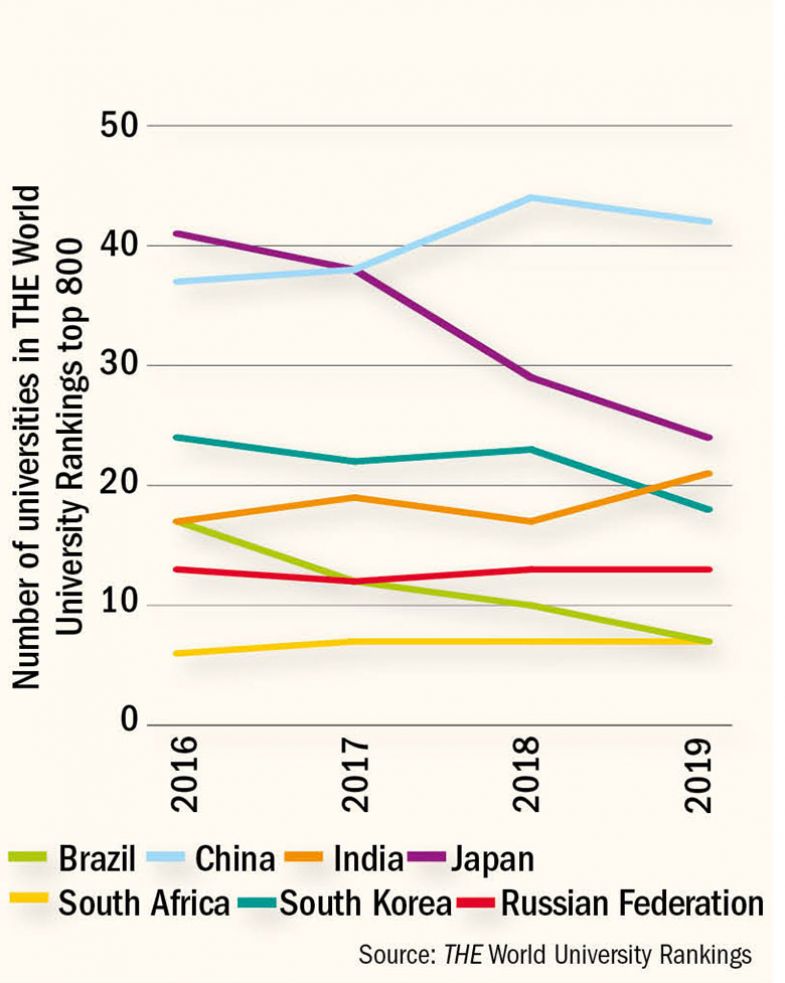
There is no shortage of national initiatives that are probing some of these routes. However, even here, their number and complexity sometimes make it difficult to keep track. One, Rashtriya Uchchatar Shiksha Abhiyan (RUSA) (meaning National Higher Education Mission), has taken a broad approach and is credited with increasing participation since its launch in 2013. Another, the Graded Autonomy Programme, has focused on removing red tape, ironically through assigning levels of institutional autonomy via a complex set of criteria.
One of the most recent initiatives is the federal government’s Institutions of Eminence programme, which, in keeping with similar approaches in other developing systems, aims to grant extra investment and autonomy to a select group of universities in a bid to improve their world standing. Unlike other so-called excellence initiatives, such as those in China and Russia, it is still in the early stages of implementation and some confusion surrounds its final form. But, on paper, the rewards seem significant: up to 10 billion rupees (around £110 million) in investment for 20 institutions, as well as measures to vastly increase their freedom.
The selection process has been troubled, with just six institutions initially recommended for funding – including one that does not yet exist – after the government-commissioned selection committee failed to identify 10 suitable public institutions and 10 private ones. The committee has since created a shortlist of 30, but wrangling over the eligibility of some of these institutions reportedly continues, and no further announcements have yet been made: a delay probably caused by government attention focusing on other priorities during the run-up to the election.
(Youth population and tertiary enrolments)
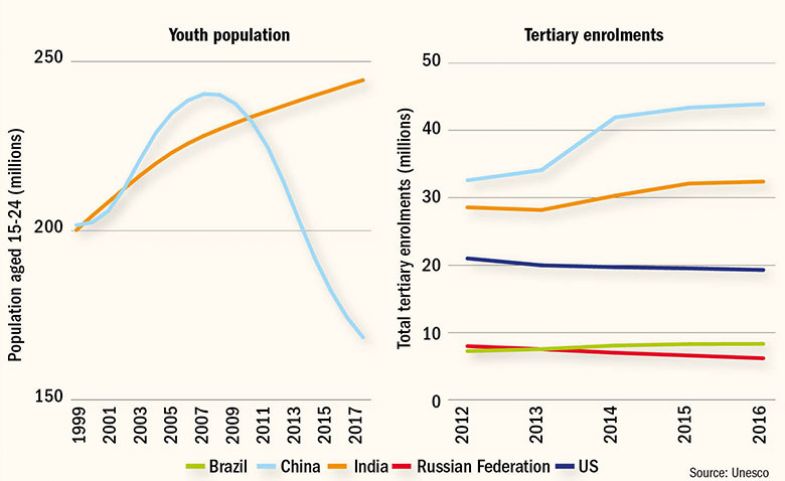
Of the 30 shortlisted institutions, 18 feature in the THE World University Rankings, and 12 in the top 800. The data suggest that they are well placed to benefit from more attention. They score more highly for citation impact than other ranked universities in India, for instance. But the upper echelons of the Indian system in general seems to be on the right trajectory: India’s representation in the top 800 has grown from 17 to 21 universities in the past three years while the other BRIC nations (apart from China) have either stalled or lost ground. India’s improvement is also notable in comparison with some developed systems like Japan, whose representation in the top 800 has almost halved since 2016.
A detailed look at top-800 Indian universities reveals a diverse mix, both geographically and constitutionally. They include the specialist, centrally funded Indian Institutes of Technology, other centrally funded public universities such as the University of Delhi, state-run public institutions like Savitribai Phule Pune University in the western region of Maharashtra and private institutions like Amrita Vishwa Vidyapeetham in the south-eastern province of Tamil Nadu. All of these have been recommended to be Institutions of Eminence.
Many observers of India’s system seem to be in broad agreement that some kind of initiative like the Eminence programme is needed to boost its number of world-class universities. But the same commentators are also quick to point out the potential flaws in its overall design, and the issues with its implementation. For instance, Antara Sengupta, a research fellow specialising in higher education at the Observer Research Foundation in Mumbai, welcomes the “dedicated attention” and resources it offers, and acknowledges that autonomy measures such as more freedom to recruit overseas staff and students are “a first for Indian higher education”. But she adds that even if the envisaged 20 Institutions of Eminence are supported, this is still “too few” compared with China’s past excellence initiatives, such as Project 211, launched in 1995 to support more than 100 universities, and Project 985, launched in 1998 and ultimately supporting 39 institutions.
(Citation impact scores)
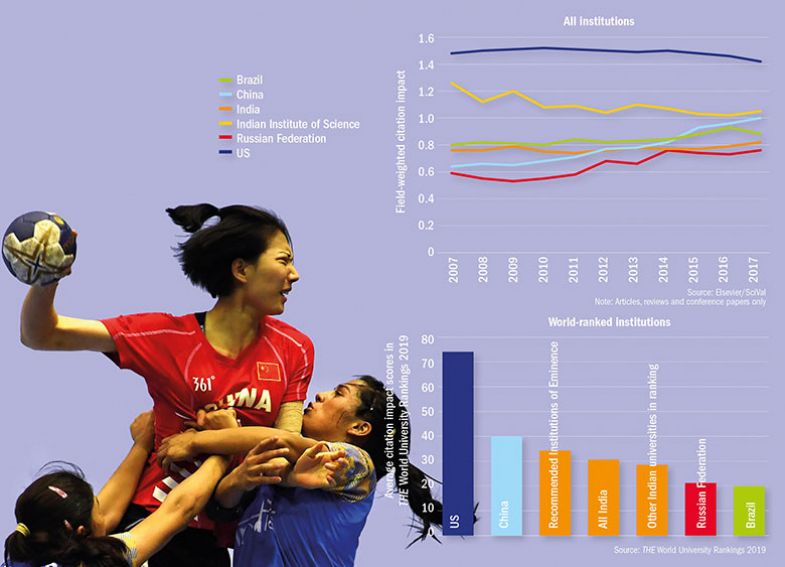
Sengupta also questions the narrowness of the six institutions selected so far: “Most are exclusively science and tech institutes,” she says. “No attention [has been] given to other streams, such as commerce and social sciences. This will only create more fragmentation in the system, resulting in less and less multidisciplinary institutes in the country.”
There has also been significant controversy over the inclusion on the shortlist of a total of three unbuilt “greenfield” universities. Philip Altbach, founding director of the Center for International Higher Education at Boston College, says this exemplifies the “craziness” that can sometimes beset schemes in Indian higher education even when the “central idea is a good one”.
He also questions whether the money being put forward for the Eminence programme is really enough – particularly given modern India’s ability to invest in a large military – not to mention a fully fledged space programme. “If I was to name the biggest problems in India then one, two, three, four and five would be funding,” he says. “Higher education is consistently underfunded at all levels. If you’re thinking about research-orientated universities in particular, they are, by global standards, drastically unfunded. India can afford [to rectify] this now. It is not like they are proposing to change the whole system [but rather] to have a small number of universities that are world class.”
A look at the international data that exist on research appears to back up this point. According to Unesco figures, India’s per capita investment in R&D is woefully behind even other BRIC nations, at just $38 per person. It is a comparison that marginally improves when the smaller number of researchers in India is taken into account, but this in itself shows how weak the country’s research capacity is. Indeed, the Unesco data on researcher density show that China has more than five times as many researchers per head of population as India does.
(Gross spending on R&D)
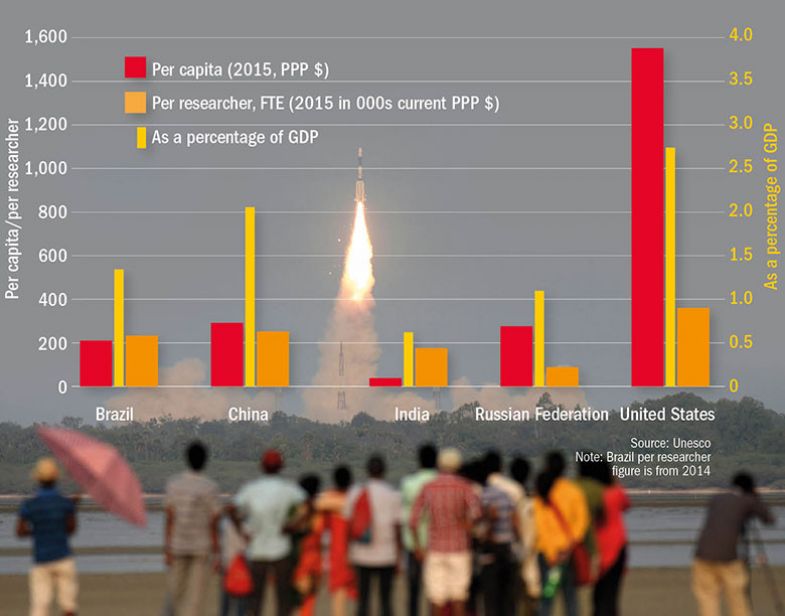
India’s lack of research investment and intensity is likely to be one of the major explanations of why the country’s overall citation impact has remained flat over the past decade while that of comparator countries, such as China and Russia, has improved. It also reflects another major problem that India must resolve to move forwards: the brain drain of home-grown academic talent and the difficulty of attracting overseas-based researchers – both foreign-born and those originally from India – to the subcontinent.
World University Rankings data starkly show how far behind other major nations even the top institutions in India are in this area. The country’s average score for proportion of international staff is behind all the BRICS nations; its average level of international co-authorship is even further behind, and still losing ground. There have been attempts to attract overseas scholars, such as the Global Initiative of Academic Networks, the Visiting Advanced Joint Research Faculty Scheme and the Scheme for Promotion of Academic and Research Collaboration, but critics point out that they sometimes only benefit a small number of institutions, while red tape can still prevent researchers staying longer term.
Then there is the major issue of academic pay in India simply being too low to attract people from abroad. Altbach points out that even for Indian PhD graduates who want to return to the country and help with its economic development, the far higher salaries available in commercial sectors such as IT and finance mean they are unlikely to choose a university career. He contrasts this with China’s Thousand Talents – recently expanded to “Ten Thousand Talents” – programme, which pays “Western salaries” to returning Chinese academics. “That is not part of Indian thinking,” Altbach says.
(Researcher density)

Sengupta suggests that more funding is also needed at early career level. “The Indian government and institutes need to provide favourable pay and conditions to PhD and postdoctoral candidates to help them produce quality research in the country,” she says. It would also be “pertinent to link research with industry and society needs, so that students feel it worthwhile to come back to the country and contribute to national causes”. And she suggests that the government offer to help fund Indian students’ studies abroad, on the proviso that they return to India to work for a set period.
A further potential route to building academic capacity in India might be to boost the number of students coming the other way. This is the aim of the recently launched Study in India initiative, which aims to double the nation’s share of the world’s international students from 1 to 2 per cent by 2023. But this will involve quadrupling the current total of less than 50,000: a huge ask in a system that, in contrast to China’s (which has seen its share of international students grow sharply in recent years), domestic students are still fleeing in increasing numbers. Many observers suggest that India would be better to focus on wholesale domestic reform.
(Global interconnections)
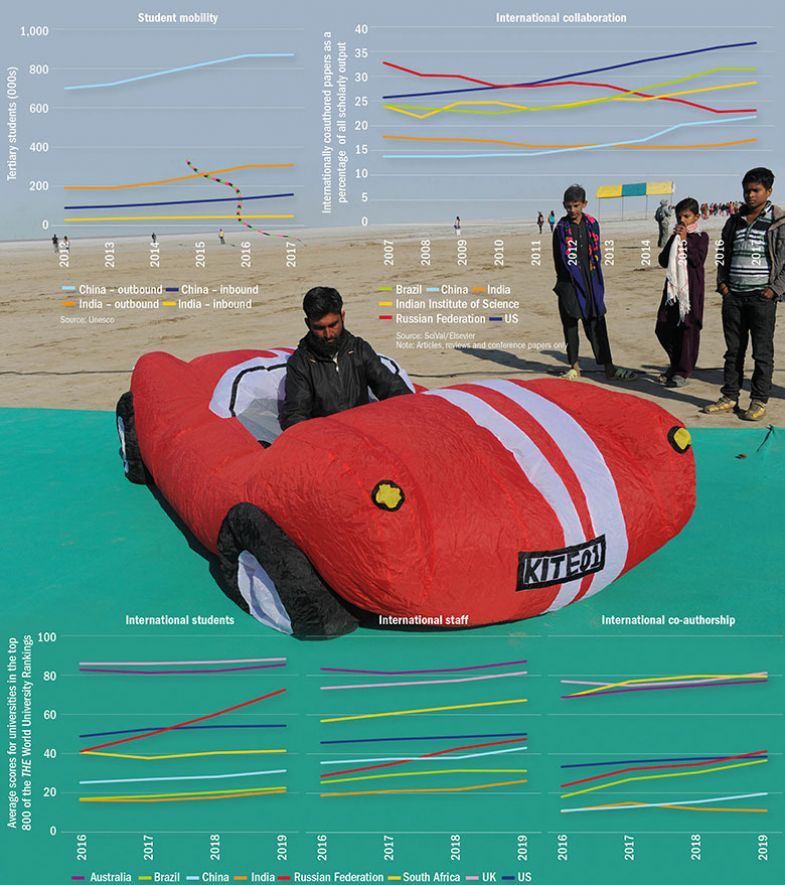
According to Craig Jeffrey, director of the Australia India Institute at the University of Melbourne, it is important to remember that the vast majority of Indian students study not at centrally funded universities but at regional institutions. Specifically, millions are enrolled at thousands of teaching-only colleges affiliated to public universities funded by India’s 36 states and union territories. “This means that the vast majority of undergraduates in India are not taught by scholars who are research-active in the sense in which this phrase is typically used globally”, he says, adding that the condition of regional institutions, especially those in the north, can be poor.
Attempts to keep the most talented students in India, and so build academic capacity from the ground up, would be helped by trying “to identify ‘key universities’ from among state-run universities…rather than focusing always on central universities and institutions”, Jeffrey adds. And the true test of the success of the Eminence programme, he adds, will be the extent to which it becomes a “catalyst” for regional improvement.
Sengupta adds that the affiliated colleges system in particular is a major issue hampering higher education in India – not least by being a huge administrative burden on state universities. But the only effective way to quickly deal with that situation would be to abolish the system – perhaps by offering “absolute autonomy to select well-performing colleges”, freeing them from “the archaic regulations under the numerous regulating agencies” in India.
But while Altbach agrees that many of the solutions to India’s woes lie at the regional level, where funding is most scant, local politics makes him pessimistic that the affiliated colleges system can be reformed.
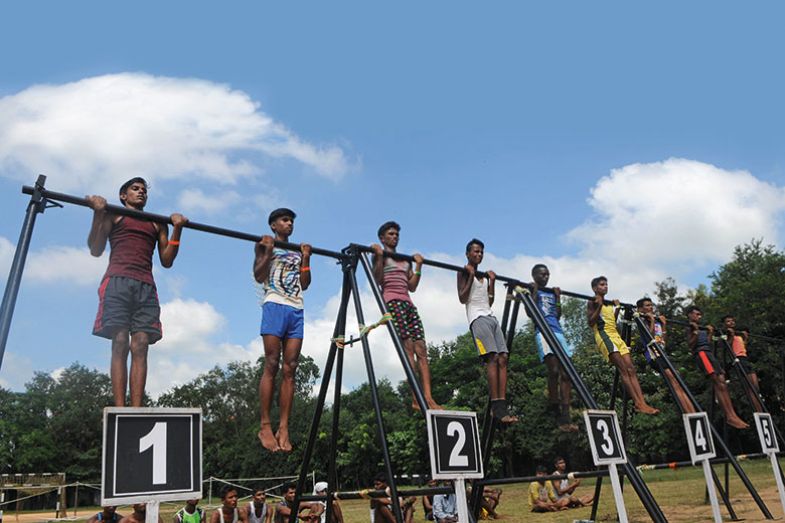
“A lot of them are run by politicians and other folk who don’t know anything about higher education,” he says, adding that these figures’ involvement is motivated solely by the opportunity afforded by running a college to obtain “votes and influence”. Therefore, such colleges require “a heavy hand of supervision. So I don’t think there is a short-term solution to this really ridiculous system.”
But Altbach is more optimistic about the growing number of new private not-for-profit universities, such as O.P. Jindal Global University and Ashoka University, which have the potential to be more innovative without being weighed down so much by regulation. “They can pay higher salaries, and some are doing so. They have attracted back some Indians from abroad who are idealistic and who go to these places [un]burdened by the bureaucracy and with some interesting educational ideas,” he says.
However, he adds that currently such institutions are primarily focused on teaching undergraduates: to become research orientated, they would need much more investment. Establishing partnerships with overseas universities might ordinarily be a solution, but restrictions on foreign investment that still prevent Western universities from setting up in India make that difficult.

So, once again, money is the sticking point; perhaps real reform in India will only take place when politicians at both the federal and regional level believe that they will win votes if they pledge major investment across the system and not just concentrated in a clutch of elite institutions.
For Pushkar, the concerns about unemployment, combined with the vast size of India’s youth vote, offer rich pickings for any political party that did make such pledges.
“It’s a puzzle, really, why India’s politicians don’t do more to connect with large numbers of young people...by placing education to the forefront [of their electoral platforms],” he says. “Politicians will pay more attention…only when there is demand from below.”
POSTSCRIPT:
Print headline: Still waiting for an Indian summer
Register to continue
Why register?
- Registration is free and only takes a moment
- Once registered, you can read 3 articles a month
- Sign up for our newsletter
Subscribe
Or subscribe for unlimited access to:
- Unlimited access to news, views, insights & reviews
- Digital editions
- Digital access to THE’s university and college rankings analysis
Already registered or a current subscriber? Login
